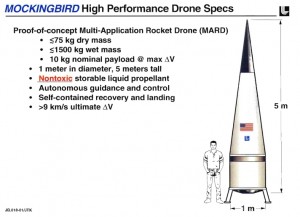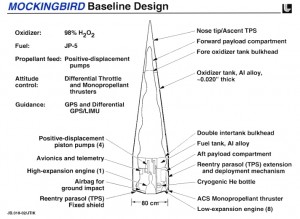Designed in the early 1990’s at Lawrence Livermore National Labs by Jordin Kare, the “Mockingbird” was a conceptual design of a single stage rocket vehicle. It was to be relatively cheap, as befits a vehicle designed officially to serve as a target. Replicating the trajectory of ballistic missiles, it was to serve as the target for ballistic missile defense systems.
But it was found that, if design properly, the simple target vehicle could do some rather more interesting things than simply get blasted. With a very lightweight aluminum rocket engine burning a combination of hydrogen peroxide and JP-5, performance in terms of thrust and Isp would be fairly high, and bulk vehicle density would also be quite high. It would, in fact, be just barely possible that this modest target vehicle would be able to attain low Earth orbit with a payload of 10 kilograms… hence the nickname “bricklifter.” Empty weight would be 75 kilograms; light enough to be picked up be two men.Gross weight would be 1500 kilograms; light enough to be carried by a largish pickup truck. And small enough that it could potentially be launche from the back of a smallish pickup truck.
Included in that 75 kilograms was re-entry shielding to allow the Mockingbird to survive re-entry, landing gear and enough rocket propellant for a soft touchdown. It was, essentially, a minimum-size Delta Clipper.
Like just about everything in aerospace, it likely would have come in over budget and over weight. But as the likes of Xcor, Armadillo Aerospace and Masten Space Systems have shown, relatively small groups on shoestring budgets (by government standards) can, with time and effort, develop just the sort of technologies needed to make vehicles like the Mockingbird work. And if one of these companies can actually build a SSTO on the scale of the Mockingbird… boy howdy, the Air Force should be *desperately* interested. Sadly, so will the regulatory agencies. But private citizens building orbital vehicles they can launch from their trucks? Awesome.
UPDATE:
An article on the Mockingbird was included in US Launch Vehicle Projects #2, available HERE.

20 Responses to “Mockingbird: Orbit in one *small* stage”
Sorry, the comment form is closed at this time.


I’m a bit skeptical it would work as designed, as LL was the home of Teller and his X-ray laser flop, followed by the “Brilliant Pebbles” SDI flop (to get 24/7 coverage against a Soviet nuclear attack would mean tens of thousands of pebble carriers in orbit at once).
However, if you could get something like this to work, it would have uses as a small mobile ICBM or mobile ASAT. As a ICBM it would be a disaster for arms control treaty verification because of its small size.
Trying to get to be recoverable is asking a lot, as just getting it into orbit with a usable payload mass is going to be a very big challenge in itself.
I suspect this is one of those cases where they were getting way too optimistic about the how high the engine ISP was going to be, and how low the vehicle structural weight was going to be, much like Black Horse. Fudge those numbers just a bit, and amazing things can be designed.
> I’m a bit skeptical it would work as designed
Sure. An SSTO this small would be *really* sensitive not only to weight growth (*paint* would be an issue), but also precision of control, among a great many other things.
> the “Brilliant Pebbles” SDI flop
AFAIK, Brilliant Pebbles did not “flop,” certainly not for technical reasons.
When you stated figuring out how many needed to be launched so that there were two or three in range of any Soviet ICBM or SLBM launch at all times, the numbers involved became astronomical; I’ve read estimates of 30,000 to 50,000 total in orbit at once, to assure a leak-proof shield. And since the lower the orbit they are in the quicker they can get to the missile after it is launched, you have to put the “garages” they are in with the sensors that detect and track the ascending missiles and launch the interceptors towards them, in pretty low orbits that are subject to atmospheric decay, so after a few years the constellation starts reentering and needs to be replaced. Meanwhile just like the Spartan/Sprint system, all the Soviets have to do is build more missiles to defeat it.
In the case of ABM’s what killed the idea was MIRV warheads; each new MIRVed missile meant building 5-10 ABMs to counter its warheads with assurance; and it was far cheaper to build another missile than the ABMs to counter it, so you could bankrupt your opponent with enough missile building.
In the case of Brilliant Pebbles, you could destroy the missile before it could deploy its MIRVs, but the down side was that any given interceptor was going to be in the wrong place in its orbit around 98% of the time to engage any particular missile launch.
> the numbers involved became astronomical; I’ve read estimates of 30,000 to 50,000 total in orbit at once
You seem to see that as a problem. Looks more like an *opportunity* to me.
Build 50,000 of them for a million dollars each (certainly doable with quantities of that size). Offer competitive contracts for launch, for at the most a million dollars each. Total build & launch budget: one hundred billion dollars. Which will put a *lot* of people to work and boost the economy in any of a number of ways. Compare that to the trillions the government deficit spends *now.* Hell, even with the USSR dead and gone, Brilliant Pebbles looks like it’d be a positive *boon.* Fire ’em up, I say!
A more recent incarnation of the Brilliant Pebbles idea was the Multiple Kill Vehicle program. Ground based interceptors were proposed rather than the space based garages. For a time it was gaining momentum in the Missile Defense Agency, but it got cancelled in 2009.
> Multiple Kill Vehicle program.
I worked on that during by irritatingly short stint as a contractor in 2008. Some funky solid rocket motor configurations, believe you me.
If you are willing to share, which team did you support?
I was (for about two months) a contractor at ATK-Elkton. A magnificently annoying tale of miscommunications on that one. Imagine my surprise when I showed up at 8AM on day one to find that not only did nobody there expect me to show up at that date and time, nobody there had ever heard of me. Imagine my continued surprise when, an hour later, Contractor #2 showed up, also unexpected. And then a day or three later when #3 showed up, and then #4.
In retrospect, I should not have been surprised when a nine-month job turned into a 2-month job. Sigh.
I am dubious if you could make the tanks work. I think the fragility would prove to be
a problem. I do believe it makes a great thought experiment, and would be worth considering.
An aluminum motor may be a real problem also. Any warm spots and it burns.
> An aluminum motor may be a real problem also.
Actually, I think an actively cooled aluminum engine is a pretty good idea. A few years back (10?) some small rocket company built a hydrogen rocket engine out of *plexiglas.* Proper use of internal vortices kept a layer of hydrogen coolant near the wall. Using something similar in conjunction with regen cooling should make an aluminum engine quite practical. Quite practical for how many flights, I don’t know Back in the 90’s I designed and regularly fired a string of biprop engines burning N2O and methanol that had aluminum injector heads, and except for the occasional hard start, they ran like champs.
Yeah, the high conductivity of aluminum should make it workable with careful design.
Looks like something that is practically tailor made for Armadillo. They’re pretty much the number one company of recent times for Hydrogen Peroxide rocket engines and the physical scale looks about right for their current operations. I would love to see them attempt something along these lines even if it doesn’t make it to orbit.
98% Hydrogen Peroxide? Isn’t that a bit… unstable? And I can think of several things to do with 10 kilos in orbit.
Stability of high concentration H2O2 depends a lot on what it comes in contact with. As I recall, copper and organic compounds are bad news for storing that oxidizer. Aluminum with it’s oxide coating is stable. Material selection and cleanliness are vital.
Has anyone suggested using spaced fissionable materials AS the rocket itself, instead of just a warhead payload–or would that even be possible–perhaps some way to use the heat of compression (not friction) instead of conventional materials for implosion? Any progress on pure fusion applications to this perhaps?
Any guesses on possible costs? (My SWAG would be “not much”.) Put a LEAP on there (SM-3 KKV) and that’s a LOT of coverage.
I think the proof of concept on such a vehicle would be interesting in itself.
If an RLV SSTO works for carrying a brick then building one to carry people is just a debate about scale.
At the very least a gas&go sounding rocket would have had plenty of its own uses.
Wait a minute, you mean that I could have ASAT capability from a jonboat? Or, more to the point, I could park a destroyer with a hand full of these little things off of the coast of a country with ballistic missile for cheap intercept? And we didn’t build these? WHAT. THE. HELL?
> I could park a destroyer with a hand full of these little things
Errr… no. The US Navy has had its fill of liquid propellant rockets, and pretty much permanently abandoned the concept many, many decades ago. if you want an example of why sailors would get twitchy, keep in mind that the torpedoes that went “funny* and sank the Kursk were loaded with hydrogen peroxide.
In any event, if you want a sub-orbital military interceptor, a solid rocket system is a far better way to go. They can sit in a can for *years* and be ready to go at the push of a button. They might weigh more and cost more, but those are relatively trivial concerns.
Using the Mockingbird as an *interceptor* would be very difficult. As shown in the designs here, it would be wholly inadequate; not only too little computational power, there’s *vastly* too little maneuver capability. And the sort of high-g lateral maneuvers that a hit-to-kill vehicle is subjected to would easily snap Mockingbird in half.
I was thinking to hit the missle in its boost phase when I assume it would be less maneuverable. And I can understand the phobia about liquid fuels.